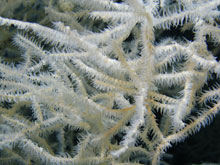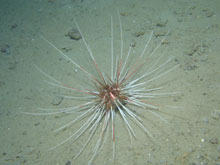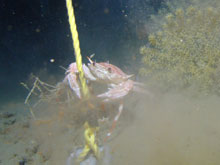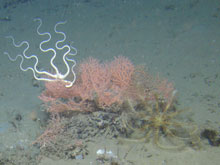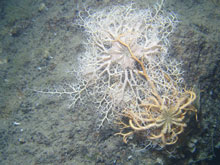More than Just a Pretty Picture
September 30, 2008
Emily Crum
Writer/Editor (Web Coordinator)
NOAA's National Ocean Service
As the Web coordinator on the expedition, one of my jobs has been to cull through the many still images collected by the remotely operated vehicle (ROV) during dives. I look for the images that have a relatively sharp focus and a clear subject matter, in efforts to pick the “best of” the bunch. On any given dive, the scientists snap anywhere from 300 to nearly 800 images. That is a lot of pixels.
As a geologist-turned-writer, I’d be the first one to admit that when I am going through these (biology-centric) images, I don’t always know exactly what I am looking at. Some of the images catch my eye because they simply look interesting. However, these images are more than just a collection of pretty pictures.
These images are data. And, when combined with another valuable form of data generated on the expedition — the hours of video footage collected by the ROV, these data will be used to help plan and refine future exploration, verify information and existing records, set new records, yield new discoveries. These data will appear in scientific papers, grace slides in scientific talks, and be shared with other researchers. Students, teachers, policy makers, members of the general public will be invited to marvel at the beauty and mystery of the deep ocean and learn from what these scientists learn.
Through this kind of sharing, the reach of this expedition grows. What may look like just another fish or curious creature to you or me may unlock a mystery for another scientist. Part of exploration is that sometimes you find what you are looking for, sometimes you don’t. And sometimes you find things that you never expected.
For example, a fish may be seen deeper than it was ever seen before. Or a coral may have been found in a part of the world where it was never known to occur. Some of the species photographed on this expedition have never been seen alive or in their natural habitats, and some have never been photographed in color.
It is through this process of discovery that we can expand our knowledge base, to better understand, protect, and preserve our ocean. We have a lot to learn (and a lot of photos to take!)
Sign up for the Ocean Explorer E-mail Update List.






















